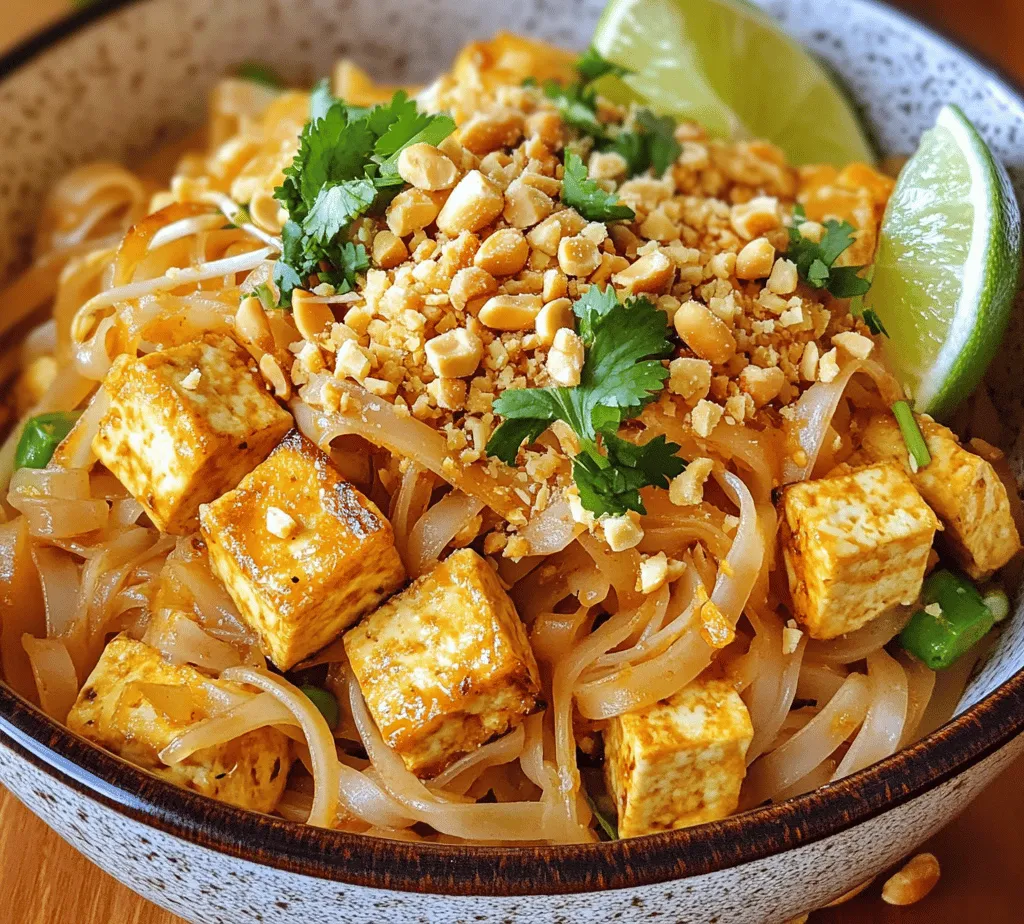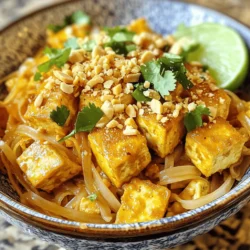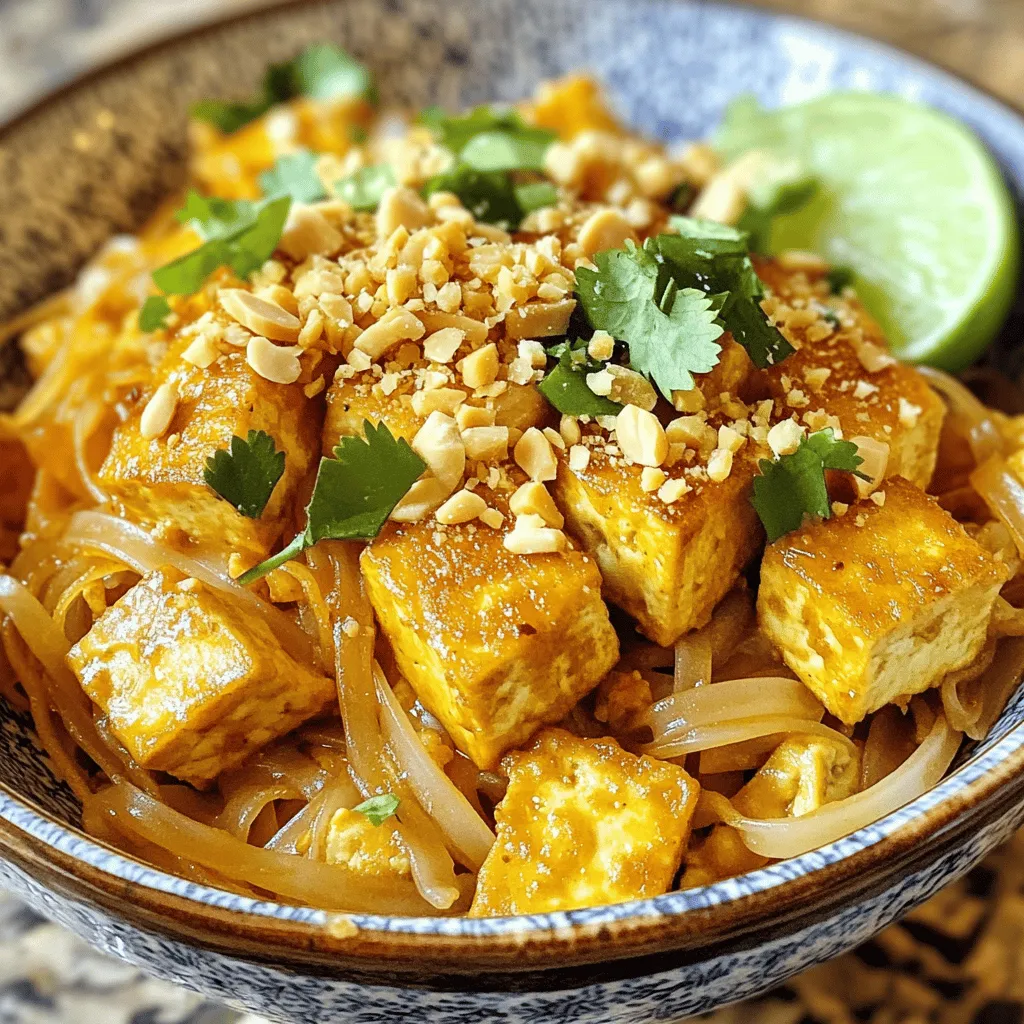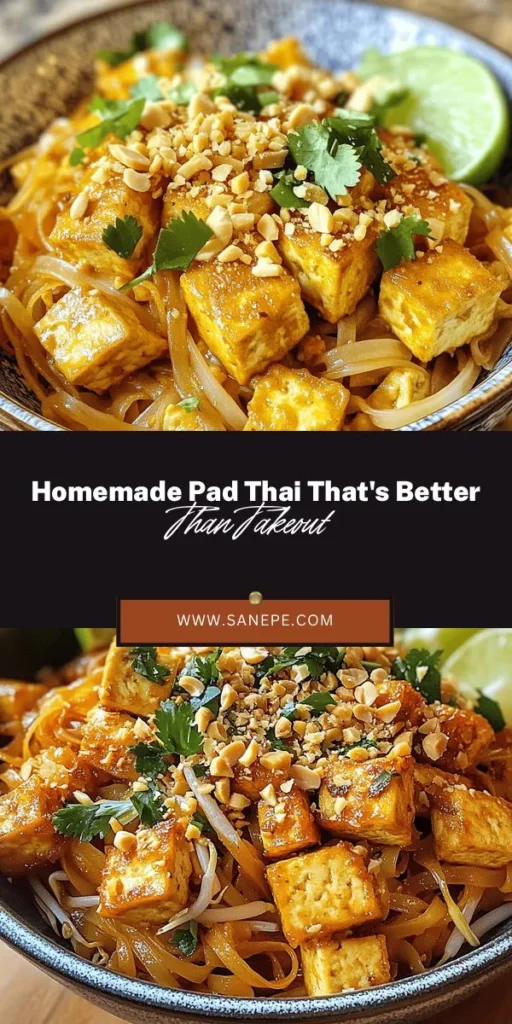Introduction
Pad Thai is more than just a dish; it’s a culinary icon that captures the essence of Thai cuisine. This stir-fried noodle dish has gained global popularity, celebrated for its harmonious blend of flavors and textures. Whether you are dining at a bustling street food stall in Bangkok or enjoying a takeout dinner at home, Pad Thai tantalizes the taste buds with its sweet, sour, and salty notes, making it a beloved choice among food enthusiasts.
There’s something truly special about preparing Pad Thai at home. Crafting your own version allows you to customize ingredients to suit your preferences, ensuring that every bite is just the way you like it. Whether you prefer the heartiness of tofu or the delicate flavor of shrimp, this recipe for Pad Thai Delight caters to both, making it an incredibly versatile dish.
In this article, we will delve into the world of Pad Thai, exploring its rich history, essential ingredients, and detailed steps for creating a delightful homemade version that rivals any restaurant.
Understanding Pad Thai
Historical Background of Pad Thai
Pad Thai’s origins trace back to the 1930s and 1940s when it emerged as a response to political and economic changes in Thailand. The government, under the leadership of Field Marshal Plaek Phibunsongkhram, promoted this dish as a national staple to foster a sense of Thai identity. The intention was to consolidate culinary practices and to encourage street vendors to sell it as a quick, nutritious meal.
The dish gained popularity due to its affordability and accessibility, quickly becoming a staple in Thai households and eateries. Over the years, Pad Thai has evolved, incorporating regional variations and ingredients, but its core elements remain cherished by many.
Significance of the Dish in Thai Culture
Pad Thai holds a special place in Thai culture, symbolizing not only national pride but also the communal aspect of dining. It’s often served as street food, where vendors deftly prepare the noodles in woks over high heat, filling the air with the irresistible aroma of frying garlic and tamarind. Whether enjoyed as a quick lunch or a celebratory feast, Pad Thai embodies the essence of sharing good food with family and friends.
Common Ingredients and Their Roles in Flavor and Texture
At its core, Pad Thai is a delicate balance of flavors and textures, primarily achieved through its key ingredients. The dish typically features rice noodles, which serve as the base, while a variety of proteins, such as shrimp or tofu, add substance. Aromatics like garlic and green onions provide depth, while the fresh crunch of bean sprouts adds a delightful contrast.
The sauce is arguably the star of the show, with components like fish sauce and tamarind paste delivering that signature sweet-sour flavor that Pad Thai is known for. Each ingredient plays a critical role in creating a dish that is complex yet approachable, making it a perfect candidate for home cooking.
Ingredients Breakdown
Overview of Key Ingredients Used in Pad Thai Delight
To create a delicious Pad Thai Delight, you’ll need a carefully curated selection of ingredients. Here’s a breakdown of what you’ll need to achieve a perfect balance of flavors:
– Rice Noodles: The foundation of Pad Thai, these thin rice noodles soak up the sauce beautifully.
– Protein: Choose between tofu or shrimp based on your preference. Both options are packed with flavor and complement the dish well.
– Aromatics: Garlic, green onions, and bean sprouts are essential for enhancing the overall taste and adding texture.
– Sauce Components: The unique Pad Thai sauce is made from fish sauce, tamarind paste, and sugar, creating that iconic flavor profile.
Description of Rice Noodles and Their Preparation
Rice noodles are essential to Pad Thai, providing the chewy texture that pairs perfectly with the sauce. When shopping for rice noodles, look for flat, wide varieties labeled as “Pad Thai noodles.” These noodles require soaking rather than boiling, which helps maintain their integrity and prevents them from becoming mushy.
To prepare the rice noodles, immerse them in warm water for about 30 minutes until they soften. Once they’ve absorbed the water, drain them and set aside. This method ensures that the noodles are pliable and ready to absorb the sauce during cooking.
Tofu vs. Shrimp: Nutritional Benefits and Flavor Profiles
When it comes to choosing your protein for Pad Thai, both tofu and shrimp offer unique benefits. Tofu is an excellent source of plant-based protein, making it a great option for vegetarians and those looking to reduce their meat intake. It has a subtle flavor that beautifully absorbs the sauce, resulting in a delightful dish.
On the other hand, shrimp adds a seafood element that is both savory and succulent. Rich in omega-3 fatty acids and low in calories, shrimp provides a lighter option that pairs wonderfully with the other ingredients. Whichever protein you choose, both options elevate the dish and ensure a satisfying meal.
Importance of Aromatics: Garlic, Green Onions, and Bean Sprouts
Aromatics play a pivotal role in elevating the flavors of Pad Thai. Garlic is a staple in Thai cuisine, contributing a warm and slightly spicy note to the dish. Green onions add a fresh crunch and mild onion flavor, while bean sprouts provide a refreshing texture that complements the noodles.
Incorporating these ingredients not only enhances the taste but also adds visual appeal to your Pad Thai, making it an inviting dish that is as pleasing to the eye as it is to the palate.
Explanation of the Sauce Components: Fish Sauce, Tamarind Paste, and Sugar
The Pad Thai sauce is where the magic happens, and it’s crucial to get the balance just right. Fish sauce is a key ingredient, providing umami and saltiness that forms the backbone of the flavor profile. Tamarind paste contributes a tangy sweetness, while sugar balances the dish, creating a harmonious blend of flavors.
For those who prefer a vegetarian option, consider using soy sauce or a plant-based fish sauce alternative. These substitutes maintain the integrity of the dish while accommodating dietary preferences.
Preparing the Noodles
Detailed Instructions on Soaking Rice Noodles
To achieve the perfect rice noodles for your Pad Thai Delight, follow these simple steps:
1. Measure the Noodles: Begin by measuring out the desired amount of rice noodles. Typically, a serving size is around 4-5 ounces per person.
2. Soak in Warm Water: Place the noodles in a large bowl and cover them with warm water. Allow them to soak for 30 minutes, or until they become soft and pliable.
3. Drain and Rinse: Once the noodles are adequately soaked, drain them in a colander and rinse under cold water to stop the cooking process. This ensures they don’t become overly soft.
4. Set Aside: After rinsing, toss the noodles lightly with a little oil to prevent them from sticking together. Set them aside while you prepare the other components of your Pad Thai.
Tips on Achieving the Perfect Noodle Texture
Achieving the ideal noodle texture is essential for a delightful Pad Thai experience. Here are a few tips to keep in mind:
– Avoid Over-Soaking: Be cautious not to soak the noodles for too long, as they can become mushy. The goal is to have them soft yet firm enough to hold their shape during cooking.
– Cook Quickly: When incorporating the noodles into your stir-fry, work quickly to avoid overcooking. The heat from the wok will continue to soften them, so a brief stir-fry is all that’s needed.
– Test for Doneness: Before adding the noodles to the pan, taste a strand to ensure it has the desired texture. It should be tender yet still have a slight bite.
Alternatives for Gluten-Free or Whole Grain Options
For those with dietary restrictions, Pad Thai can easily accommodate gluten-free or whole grain options. Look for gluten-free rice noodles available in most grocery stores or health food shops. These noodles will behave similarly to traditional rice noodles, allowing you to enjoy the dish without compromise.
For a whole grain alternative, consider using brown rice noodles. They offer a nuttier flavor and added fiber, making your Pad Thai both nutritious and satisfying.
Crafting the Perfect Sauce
Step-by-Step Guide on Mixing the Sauce Ingredients
Creating the perfect Pad Thai sauce is crucial for achieving that signature flavor. Here’s a simple guide to mixing your sauce:
1. Gather Ingredients: You will need fish sauce, tamarind paste, sugar, and a splash of water to help dissolve the ingredients.
2. Combine in a Bowl: In a medium-sized bowl, combine 3 tablespoons of fish sauce, 2 tablespoons of tamarind paste, and 1 tablespoon of sugar.
3. Whisk Together: Use a whisk or fork to mix the ingredients thoroughly until the sugar is completely dissolved. The sauce should be well-combined and have a balanced flavor profile of salty, sweet, and tangy.
4. Taste and Adjust: Before using, taste the sauce and adjust the flavors as needed. If you prefer it sweeter, add a bit more sugar; for a saltier profile, increase the fish sauce.
5. Set Aside: Once your sauce is perfectly balanced, set it aside until you’re ready to add it to your stir-fry.
With this detailed preparation of Pad Thai Delight, you are well on your way to creating an authentic and flavorful dish that embodies the heart of Thai cuisine. In the next section, we will explore the cooking process, bringing all these delectable components together for a truly delightful experience.

The Role of Each Ingredient in Balancing Flavors
In the vibrant world of Pad Thai, each ingredient plays a pivotal role in creating a harmonious blend of flavors. The interplay between sweet, salty, sour, and umami is what makes this dish truly delightful.
– Noodles: Rice noodles serve as the foundation, providing a chewy texture that holds onto the sauce and other ingredients. Their subtle flavor allows the other components to shine.
– Protein: Whether you opt for tofu, shrimp, or chicken, the protein adds richness. Tofu, particularly, absorbs flavors beautifully, enhancing the dish’s complexity. Shrimp offers a briny sweetness that pairs well with the tanginess of lime.
– Vegetables: Bean sprouts, scallions, and carrots provide crunch and freshness, balancing the richness of the sauce and protein. They also introduce additional nutrients, making the dish more wholesome.
– Sauce: The combination of tamarind paste, fish sauce, and sugar creates a perfect balance of sweet and tangy. Adjusting these ingredients can tailor the dish to your preference. For a sweeter profile, increase the sugar; for a tangier taste, add more tamarind.
– Garnishes: Peanuts and lime wedges not only add flavor and texture but also contribute visual appeal. Cilantro adds freshness, while a sprinkle of chili flakes can bring heat.
Suggestions for Adjusting Sauce Ingredients for Personal Taste
Personalizing the sauce is where you can truly make Pad Thai your own. Here are some recommendations for adjusting the sauce to suit your taste:
– Sweetness: If you prefer a sweeter Pad Thai, add a tablespoon of brown sugar or palm sugar. Start with a small amount and adjust gradually to avoid overwhelming the dish.
– Sourness: For those who enjoy a more pronounced tang, consider increasing the tamarind paste or adding a splash of rice vinegar. This not only enhances the flavor but also balances the sweetness.
– Saltiness: Depending on your preference, you can modify the amount of fish sauce. Remember that fish sauce is quite salty, so increase it slowly and taste as you go.
– Spiciness: To spice things up, incorporate chili paste or fresh chilies into the sauce. Alternatively, serve with sliced bird’s eye chilies on the side for those who prefer to add heat to their own servings.
Cooking Techniques for Pad Thai
Importance of Using the Right Cooking Vessel
The choice of cooking vessel is crucial when preparing Pad Thai. A wok is ideal for stir-frying due to its high heat retention and the ability to toss ingredients quickly. If a wok is unavailable, a large skillet can suffice, but be mindful to maintain high heat throughout the cooking process to prevent sticking and ensure a proper sear.
Tips on Achieving the Ideal Sauté for Tofu or Shrimp
For tofu, start by pressing it to remove excess moisture, then cut it into bite-sized cubes. Sauté the tofu in oil until golden brown on all sides to develop a crispy exterior. For shrimp, ensure they are dry before cooking. Sauté them briefly until they turn pink and opaque, taking care not to overcook, as they can become rubbery.
Best Practices for Stir-Frying: Temperature Control and Timing
To achieve the best results, preheat your wok or skillet until it’s very hot. Add oil and allow it to shimmer before introducing your ingredients. Stir-fry in batches if necessary to avoid overcrowding, which can lower the temperature. Quick, high-heat cooking is key to preserving the texture and flavor of your ingredients.
Combining Ingredients
Instructions on Integrating the Noodles with the Sauce
Once your protein and vegetables are cooked, it’s time to add the noodles. Ensure they are softened and drained before adding them to the pan. Pour the sauce over the noodles, and using tongs or a spatula, gently toss everything together, ensuring the noodles are well-coated.
Techniques for Evenly Distributing Flavors Throughout the Dish
To ensure that every bite is packed with flavor, continue to toss the noodles with the ingredients for a couple of minutes. This helps the sauce penetrate the noodles and distribute the ingredients evenly. If the mixture seems dry, you can add a splash of water or more sauce to help with the integration.
How to Incorporate Eggs and Vegetables for Texture and Nutrition
Push the noodle mixture to one side of the pan, creating space for the eggs. Crack the eggs directly into the pan and scramble them until just set, then mix them into the noodles. This adds a creamy texture and extra protein. Finally, add the vegetables and cook briefly until they are just tender but still vibrant.
Serving Suggestions
Plating Techniques for a Visually Appealing Presentation
Presentation matters, especially for a dish as colorful as Pad Thai. Use a large plate or bowl, and start with a generous mound of noodles in the center. Arrange the protein and vegetables artfully on top, allowing some noodles to peek through.
Recommended Garnishes and Their Flavor Contributions
Garnishing elevates the dish aesthetically and flavor-wise. Sprinkle crushed peanuts over the top for crunch and a nutty flavor. Fresh cilantro adds brightness, while lime wedges provide a tangy kick. A dash of chili flakes can also offer an extra layer of flavor if desired.
Pairing Ideas: Beverages and Side Dishes that Complement Pad Thai
Pad Thai pairs wonderfully with a variety of beverages. Consider serving it with a chilled Thai iced tea or a light lager to balance the dish’s flavors. For side dishes, a simple cucumber salad with a light vinaigrette can provide a refreshing contrast to the richness of Pad Thai.
Nutritional Information
Breakdown of Calories and Macronutrients Per Serving
A typical serving of Pad Thai, made with tofu and vegetables, contains approximately 400-600 calories, depending on the portion size and specific ingredients used. The macronutrient distribution is roughly 15-20g of protein, 50-70g of carbohydrates, and 15-25g of fat. Adjusting the amount of oil and sugar in the sauce can help manage the calorie count.
Health Benefits of Key Ingredients
– Tofu: A great source of plant-based protein, tofu is also rich in iron and calcium.
– Vegetables: The variety of vegetables not only adds color but also provides essential vitamins and minerals, contributing to overall health.
– Peanuts: These provide healthy fats and are a good source of protein, fiber, and antioxidants, making them a nutritious addition.
Tips for Making Pad Thai Healthier Without Sacrificing Flavor
To create a lighter version of Pad Thai, consider the following modifications:
– Use less oil for stir-frying or substitute with a non-stick spray.
– Opt for whole grain or vegetable-based noodles for added fiber.
– Increase the amount of vegetables to enhance nutritional value while reducing calorie density.
– Limit added sugars in the sauce and rely more on the natural flavors of the ingredients.
Conclusion
Pad Thai Delight is not just a meal; it’s an experience that brings together a medley of flavors and textures. This dish is a testament to the beauty of Thai cuisine, showcasing its versatility and ability to cater to various tastes. The process of making Pad Thai at home allows for creativity and customization, letting you tailor the flavors to your liking.
We encourage you to try making this beloved dish in your kitchen. Experiment with different proteins, vegetables, and sauce ratios to discover your perfect Pad Thai. Enjoying homemade Pad Thai is not just about savoring delicious food; it’s also about embracing the cultural significance of sharing meals with loved ones. So gather your ingredients, heat up your wok, and embark on a culinary adventure that will delight your taste buds and nourish your spirit.


